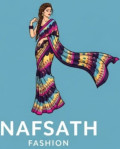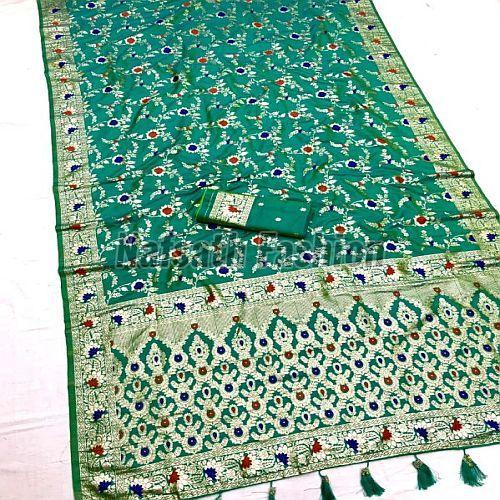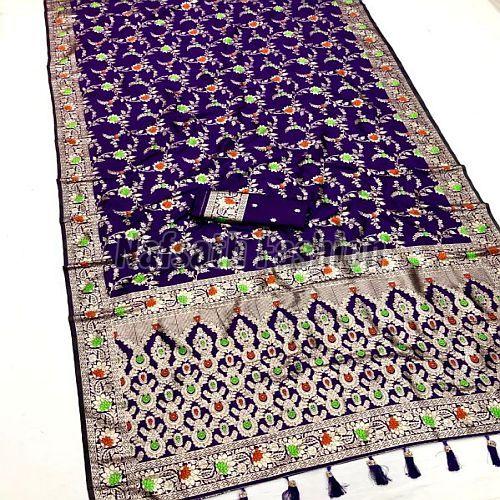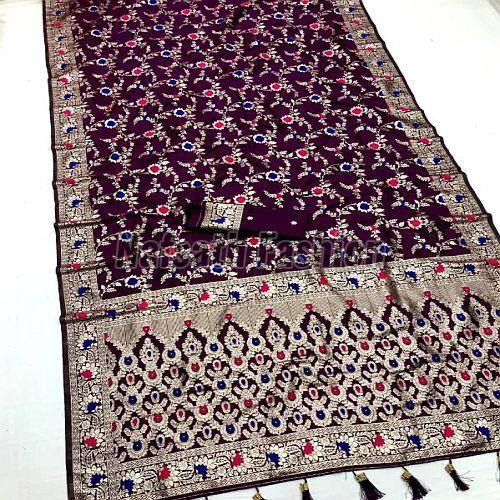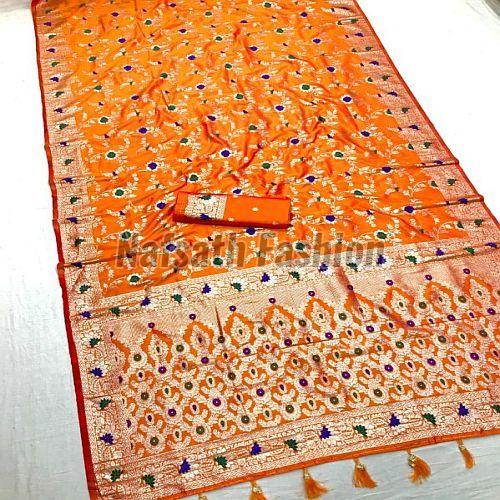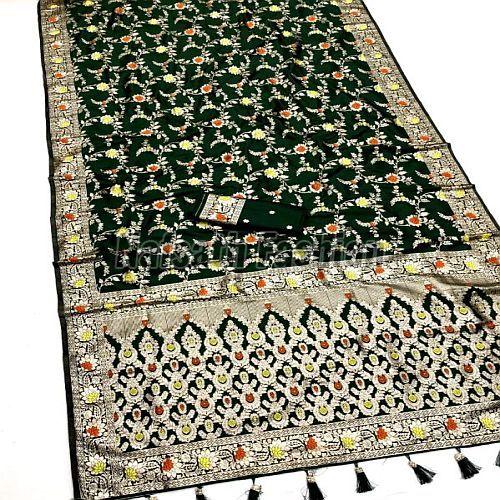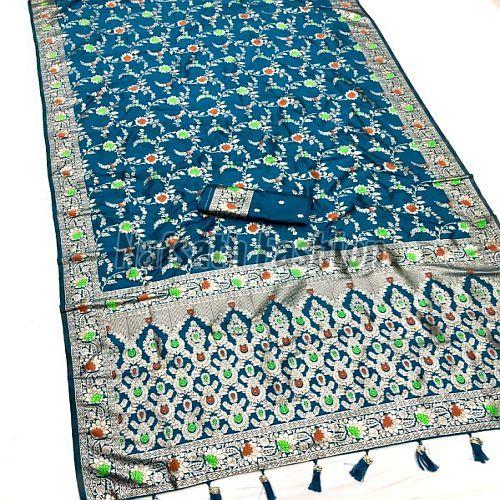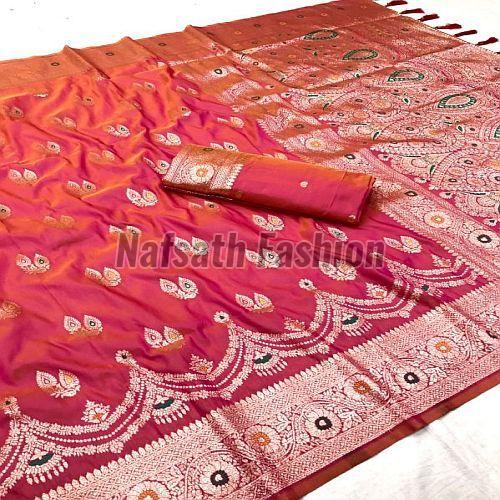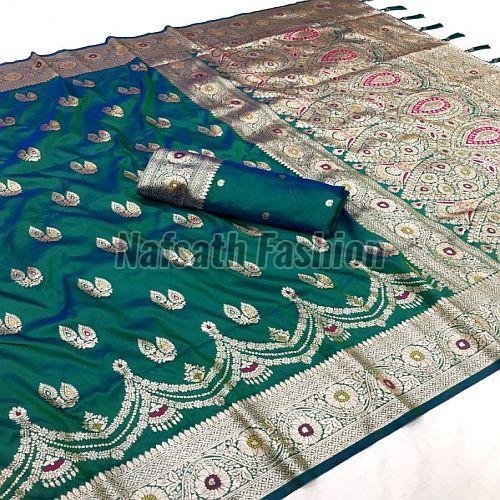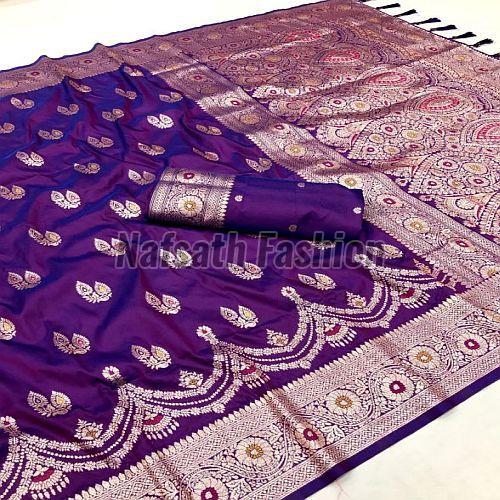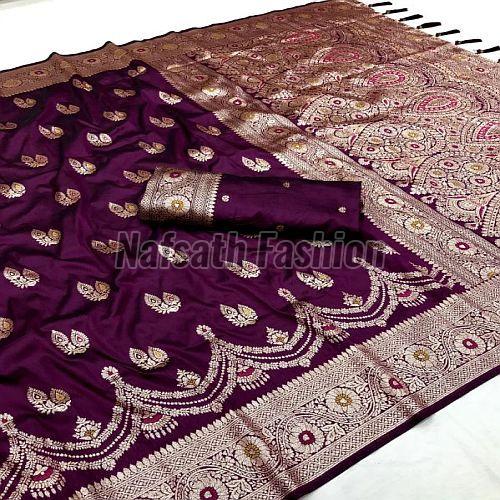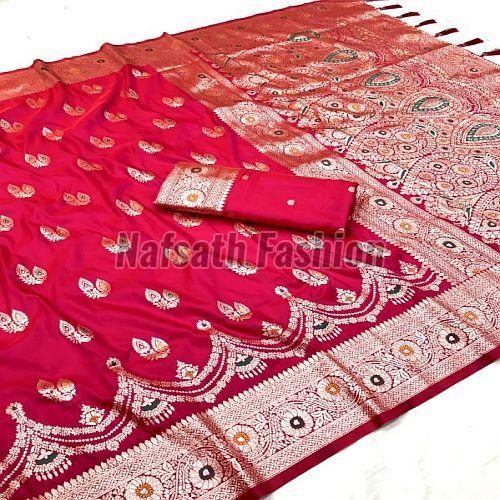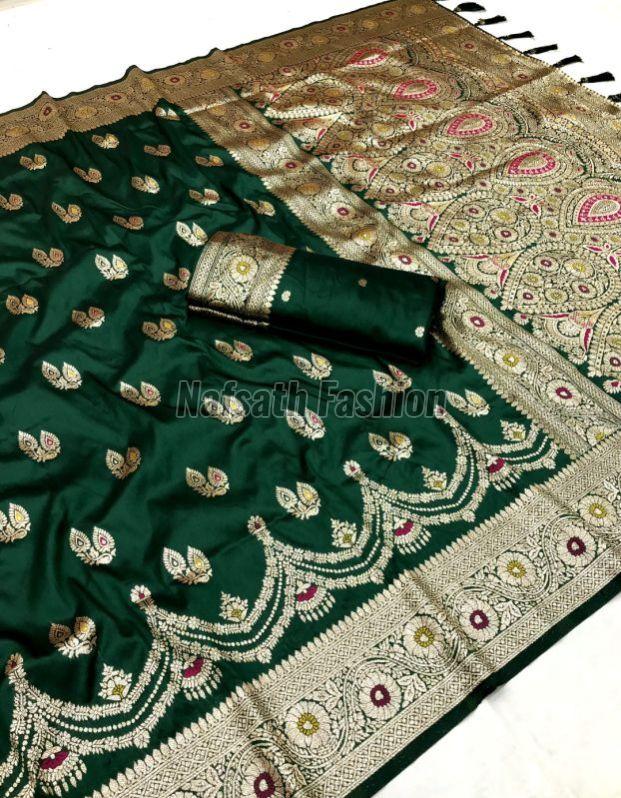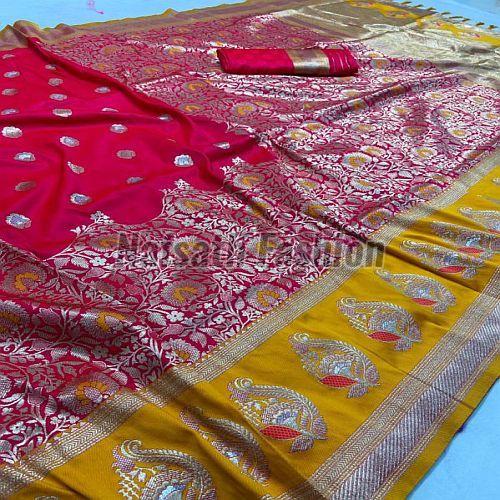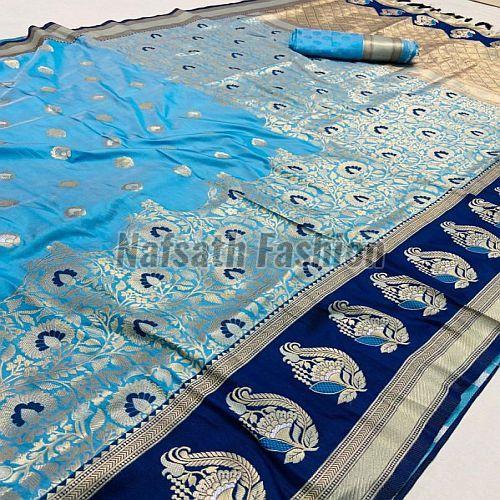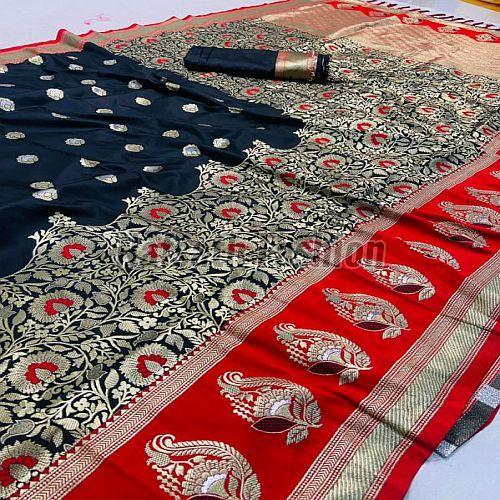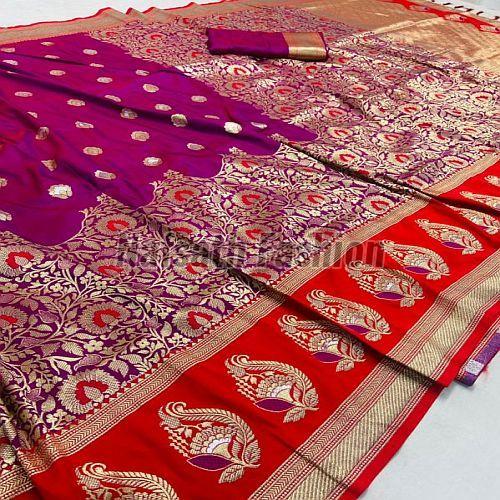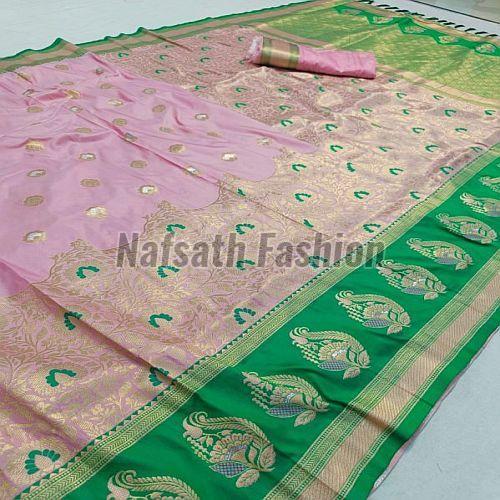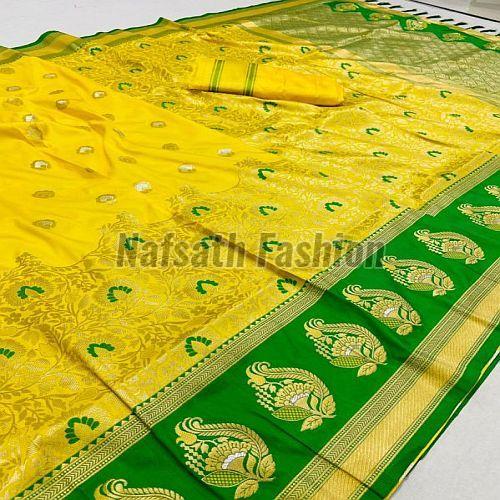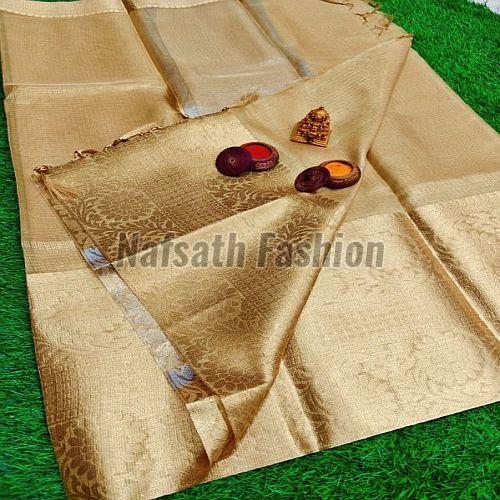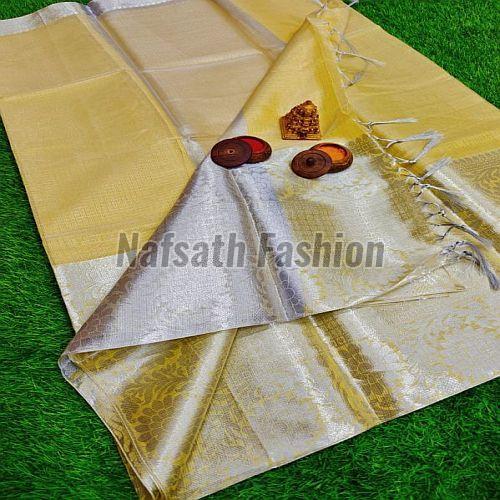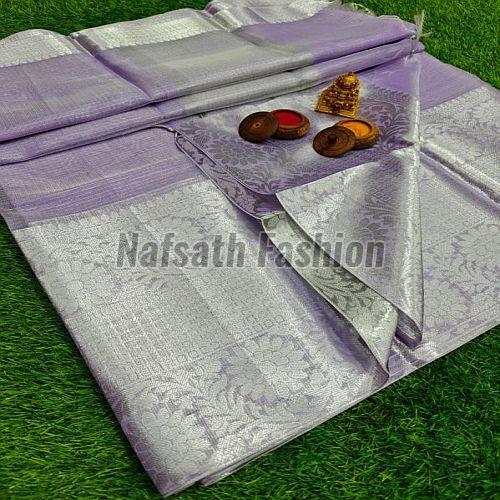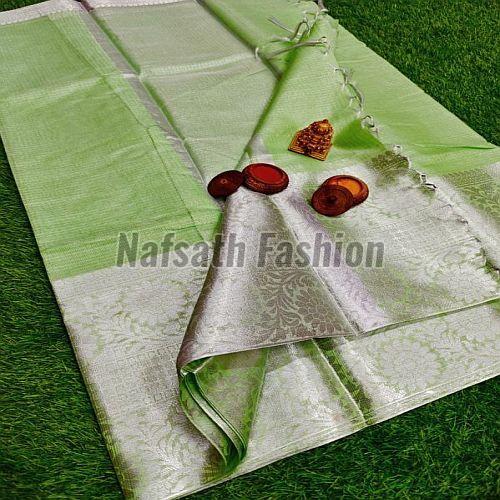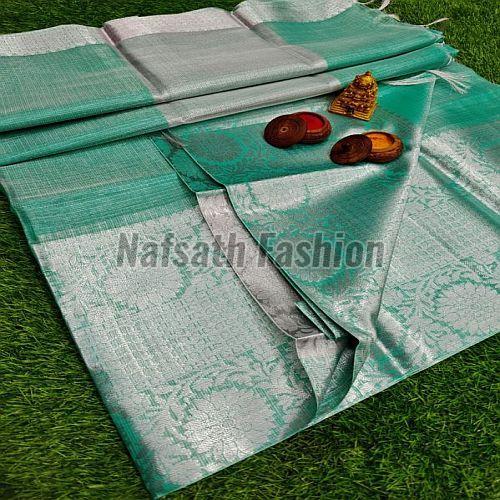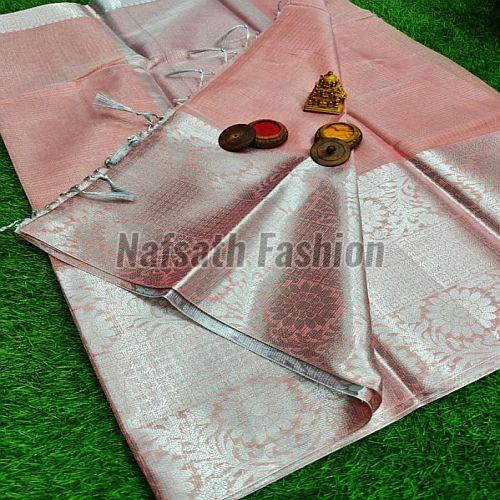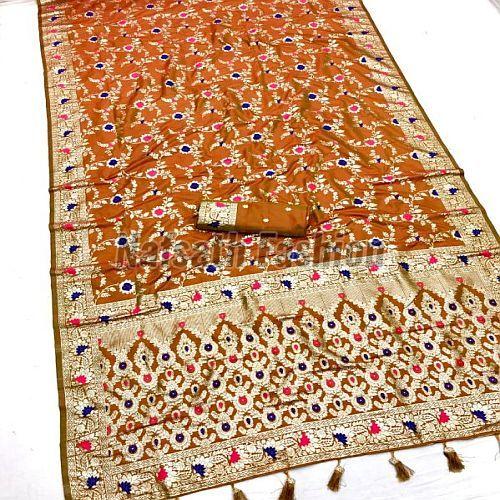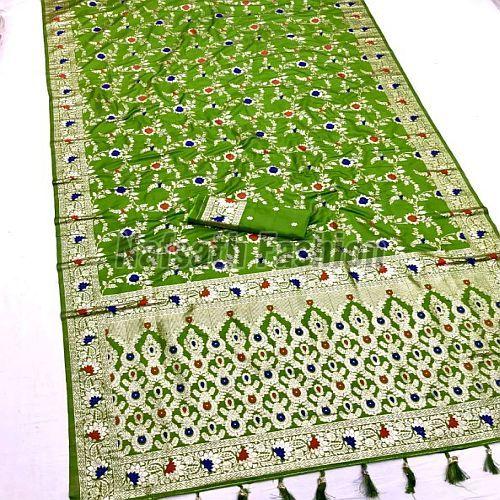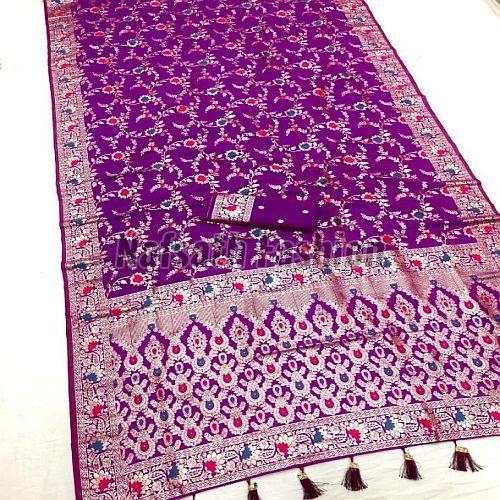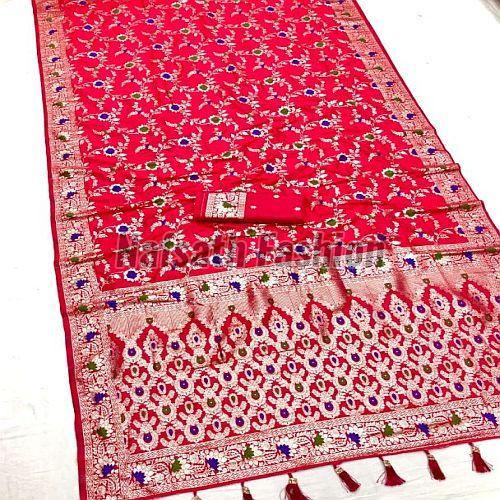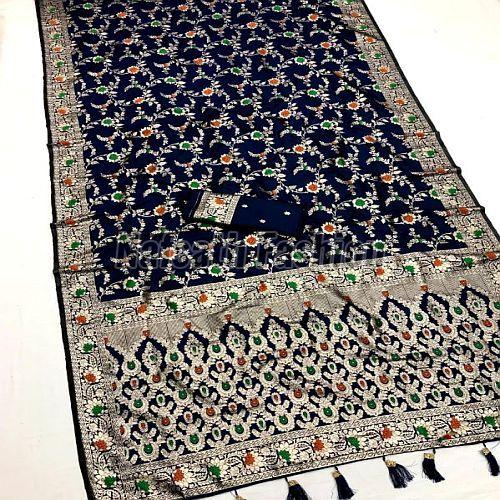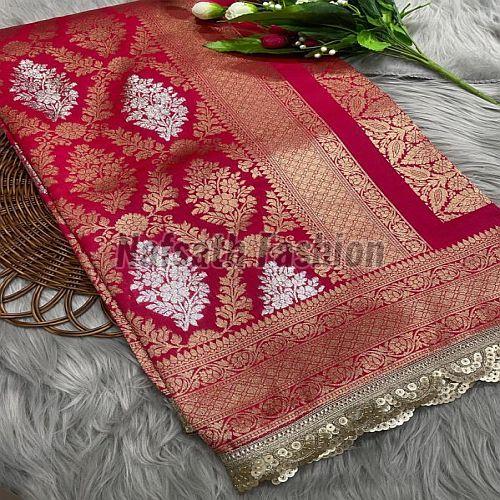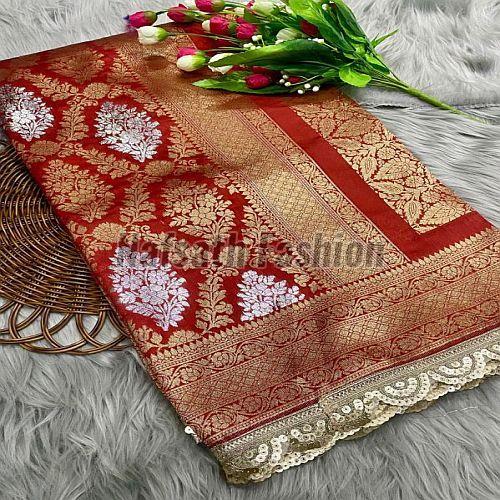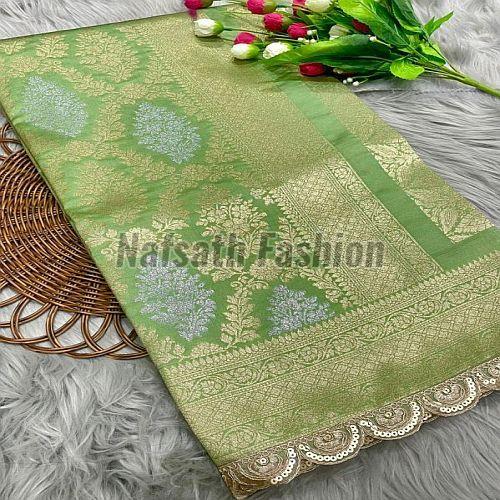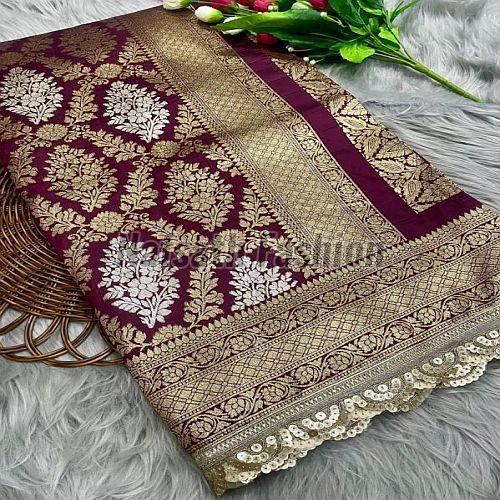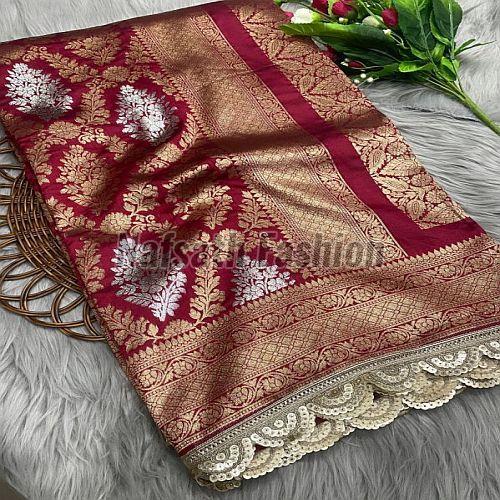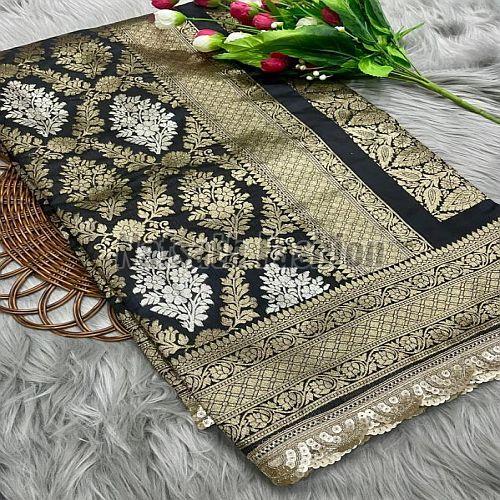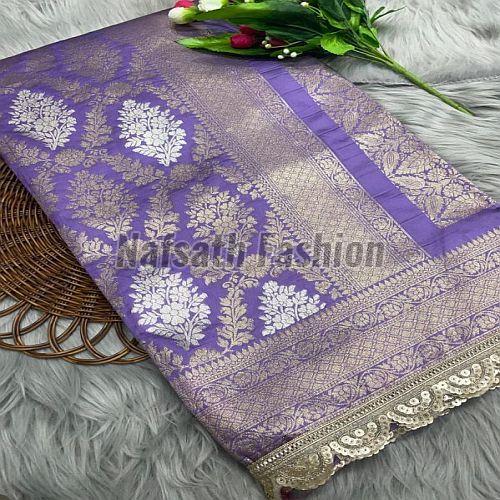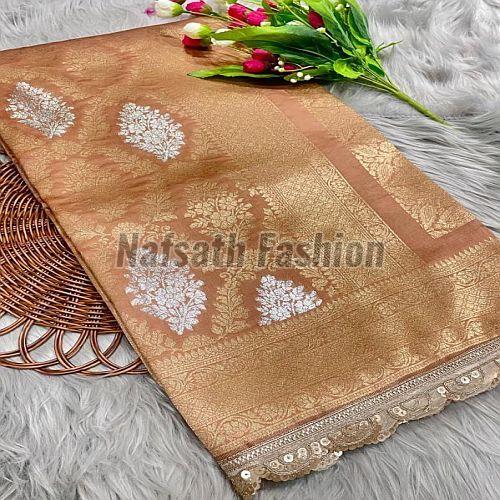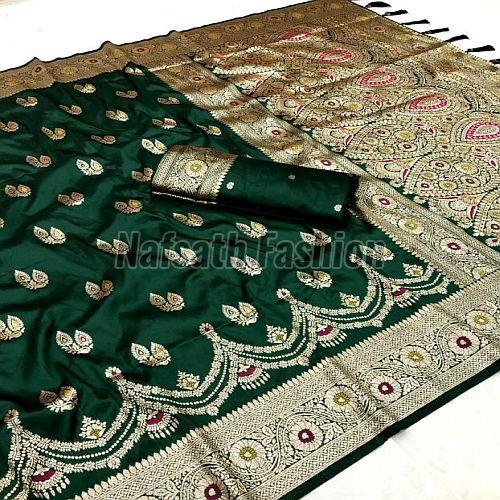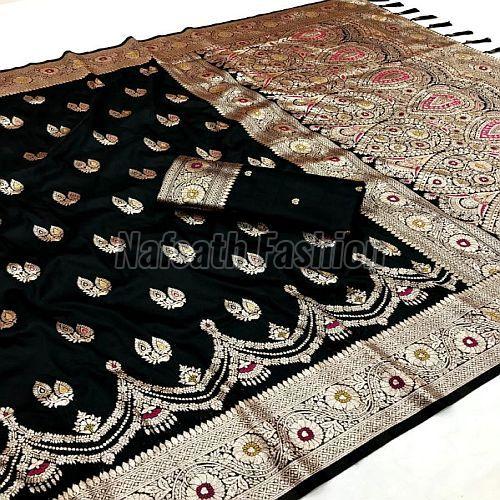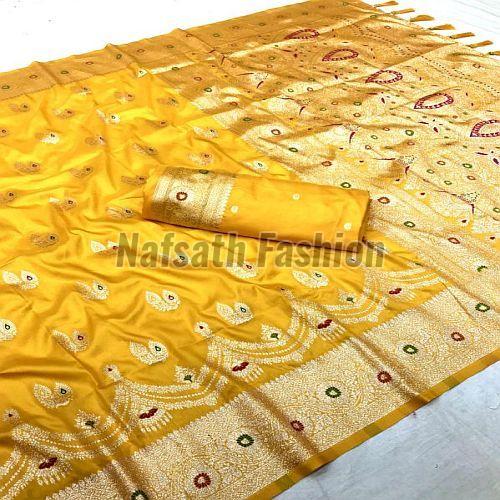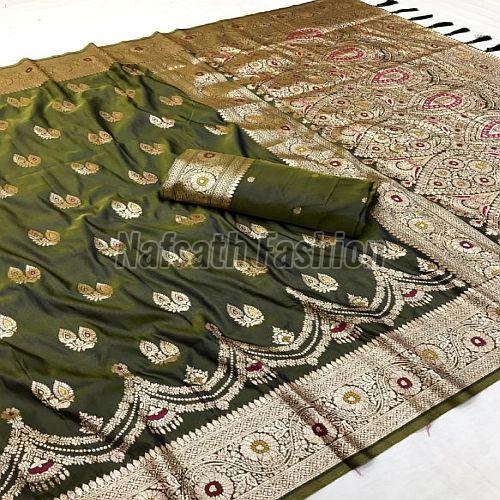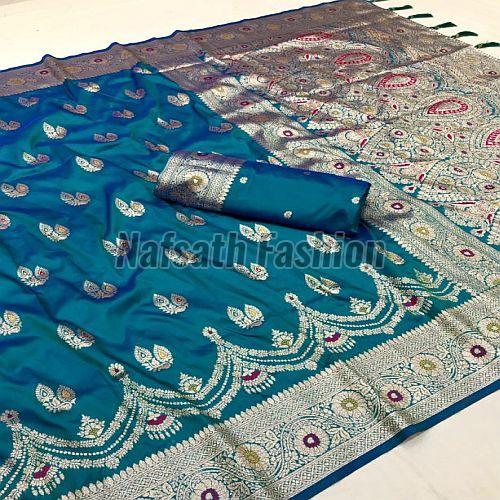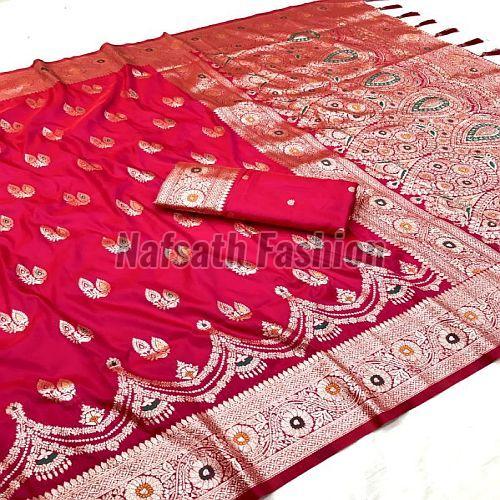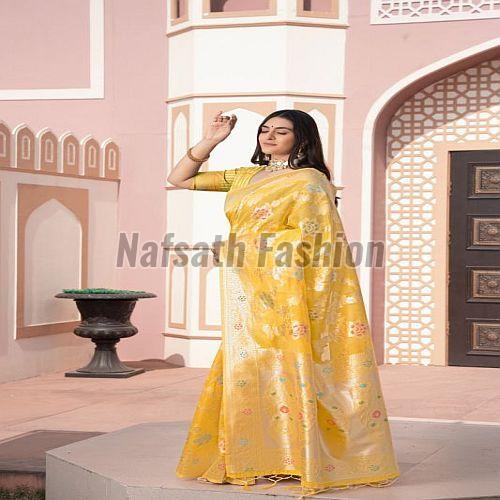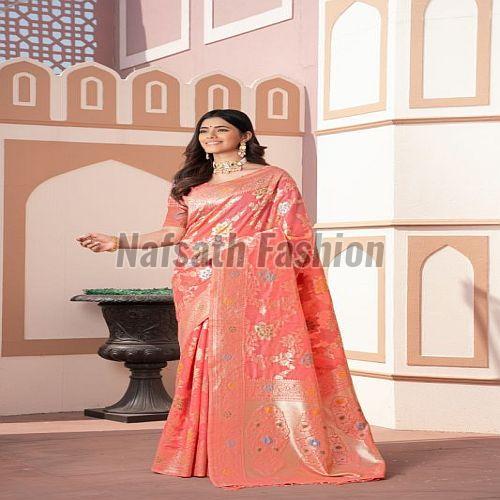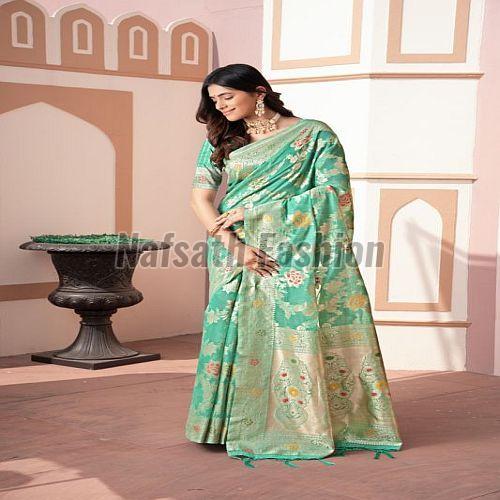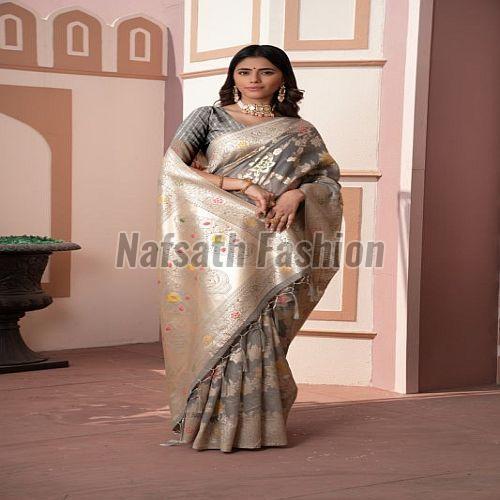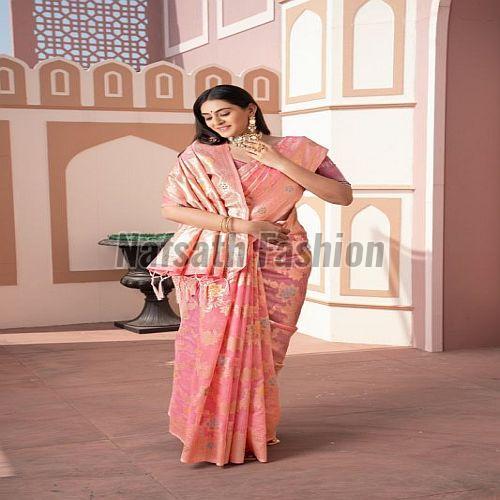Banarasi Saree
Leading Exporters, Wholesaler, Retailer and Trader of Banarasi Satin Silk Zari Work Saree, Beautiful Banarasi Weaving Silk Saree, Beautiful Zari Work Banarasi Silk Saree, Fancy Banarasi Silk Saree, Floral Design Multicolor Banarasi Silk Saree, Zari Border Banarasi Katan Silk Saree, Zari Border Soft Weaving Banarasi Silk Saree, Zari Silk Blend Banarasi Saree and Zari Work Soft Banarasi Katan Silk Saree from Kanchipuram.
| Business Type | Exporter, Supplier, Retailer, Trader |
| Feature | Impeccable Finish, Skin Friendly |
| Pattern | Designer |
| Type | Banarasi Satin Silk Saree |
| Work | Zari |
| Brand Name | Banarasi Silk Saree With Meenakari Zari Weaving Work |
| Material | Satin Silk |
| Color | Available in Different Color |
Creating a Banarasi sari is a labor-intensive process that often takes weeks or even months, depending on the complexity of the design. The key steps involved are:
- Sourcing Raw Materials: High-quality silk threads are primarily sourced from Karnataka and West Bengal. Zari, the metallic thread, is made by wrapping fine silver or gold around a cotton or silk core.
- Designing the Motifs: Skilled designers create intricate patterns inspired by nature, Mughal art, and geometric shapes. These designs are transferred onto paper, serving as a blueprint for the weavers.
- Preparing the Loom: The silk threads are dyed in vibrant colors and then stretched onto the loom to form the warp (vertical threads) and weft (horizontal threads).
- Weaving: Expert weavers interlace the warp and weft threads on traditional handlooms or power looms, meticulously following the design. Techniques like kadhua (individual motif weaving) and jangla (all-over pattern weaving) are used to create elaborate designs.
- Adding Zari Work: Metallic threads are skillfully incorporated into the weaving process to highlight the motifs and add a touch of luxury.
- Finishing: Once the weaving is complete, the sari is cut from the loom, and any loose threads are trimmed and finished.
| Business Type | Exporter, Supplier, Retailer, Trader |
| Set Content | With Blouse Piece |
| Pattern | Designer |
| Wash Care | Machine Wash |
| Feature | Shrink-Resistant |
| Material | Pure silk |
| Color | Various Traditional Colors And Designs |
Handloom Banarasi sarees will have floats (loose threads) on the back, where the design is woven in. Machine-woven sarees have a smoother finish.
- Examine the Zari: Real zari (gold or silver) might show a reddish (for gold-coated silver) or silver thread underneath when lightly scratched. Imitation zari may reveal white or plastic threads.
- Look for Pin Markings: These are small holes on the selvage (edges) of handloom sarees, used to secure the fabric on the loom.
- Feel the Texture: Pure silk is smooth and has a natural sheen.
- Inspect the Design: Look for traditional Mughal-inspired motifs like Amru, Ambi, and Domak, as well as intricate floral and geometric patterns.
- Check for a Plain Silk Patch: On the pallu, there might be a 6-8 inch section of plain silk before the main design begins.
- GI Tag: Authentic Banarasi sarees may have a Geographical Indication (GI) tag, ensuring they are produced in the designated regions around Varanasi.
- Price: Pure Banarasi silk sarees with intricate zari work are usually more expensive due to the quality of materials and labor involved.
- Burn Test (Use with Caution): A pure silk thread will burn like hair, leaving brittle ash. Synthetic threads will melt and smell like plastic.
- Seller's Authenticity: Purchase from reputable stores or verified online platforms.
| Business Type | Exporter, Supplier, Retailer, Trader |
| Pattern | Designer |
| Set Content | With Blouse Piece |
| Saree Length | 7.5 Meter |
| Wash Care | Machine Wash |
| Feature | Shrink-Resistant |
| Work Type | Zari Work |
| Material | Silk |
| Color | Available in Different Color |
Made with genuine gold and silver threads. These are the most expensive and were traditionally used for royalty.
- Semi-Real Zari: Uses a base of copper or silver coated with gold. This offers a more affordable alternative to real zari while still maintaining a good luster.
- Tested Zari (or Imitation Zari): Uses metallic threads made from copper or other base metals that are electroplated with a golden or silvery finish. These are more cost-effective.
- Metallic Zari: Modern zari made from synthetic metallic yarns, which are lightweight and tarnish-resistant.
- Zardozi: A heavy and elaborate type of zari embroidery that often incorporates beads, sequins, and other embellishments to create three-dimensional designs.
- Kamdani: A lighter form of zari work using flattened metallic wire to create delicate patterns, often seen on lighter fabrics.
- Mina Work: Zari work that resembles enamel designs, often using gold threads to create vibrant patterns.
- Gota Work: A type of zari application where woven gold or silver ribbons (gota) are cut into shapes and appliqued onto the fabric, often with further embellishment using zari thread.
| Business Type | Exporter, Supplier, Retailer, Trader |
| Set Content | With Blouse Piece |
| Pattern | Designer |
| Saree Length | 6.3 M (with Blouse Piece) |
| Wash Care | Machine Wash |
| Feature | Shrink-Resistant, Anti-Wrinkle |
| Material | Banarasi Silk |
| Color | Available in Different Color |
| Business Type | Exporter, Supplier, Retailer, Trader |
| Pattern | Designer |
| Set Content | With Blouse Piece |
| Saree Length | 6.3 M (with Blouse Piece) |
| Wash Care | Machine Wash |
| Feature | Shrink-Resistant |
| Material | Silk |
| Color | Available in a variety of colors |
Creating a Banarasi sari is a labor-intensive process that often takes weeks or even months, depending on the complexity of the design. The key steps involved are:
- Sourcing Raw Materials: High-quality silk threads are primarily sourced from Karnataka and West Bengal. Zari, the metallic thread, is made by wrapping fine silver or gold around a cotton or silk core.
- Designing the Motifs: Skilled designers create intricate patterns inspired by nature, Mughal art, and geometric shapes. These designs are transferred onto paper, serving as a blueprint for the weavers.
- Preparing the Loom: The silk threads are dyed in vibrant colors and then stretched onto the loom to form the warp (vertical threads) and weft (horizontal threads).
- Weaving: Expert weavers interlace the warp and weft threads on traditional handlooms or power looms, meticulously following the design. Techniques like kadhua (individual motif weaving) and jangla (all-over pattern weaving) are used to create elaborate designs.
- Adding Zari Work: Metallic threads are skillfully incorporated into the weaving process to highlight the motifs and add a touch of luxury.
- Finishing: Once the weaving is complete, the sari is cut from the loom, and any loose threads are trimmed and finished.
| Business Type | Exporter, Supplier, Retailer, Trader |
| Type | Banarasi Silk Saree |
| Material | Katan Silk |
| Color | Available in a variety of colors |
| Pattern | Intricate |
| Speciality | Impeccable Finish, Shrink Resistant |
| Work | Zari |
A premium Banarasi Katan silk saree with zari weaving and a lace border would be a truly exquisite and luxurious saree, combining several desirable elements:
- Banarasi: This signifies the saree's origin from Varanasi, known for its rich weaving heritage and high-quality silk.
- Katan Silk: This refers to a specific type of pure silk where the filaments are twisted together to create a strong, durable, and lustrous fabric. Katan silk is considered one of the finest qualities of silk used for Banarasi sarees, giving it a smooth and elegant drape.
- Zari Weaving: This indicates that the saree features intricate patterns and designs woven using metallic threads, traditionally gold or silver, adding a touch of opulence and grandeur. The zari work can range from delicate borders and motifs to elaborate, all-over brocade.
- Lace Border: This is an additional decorative element where a lace trim is attached to the border of the saree. The lace could be made from various materials like silk, cotton, or synthetic fibers and can feature different patterns, adding a delicate and sometimes contemporary touch to the traditional Banarasi saree.
| Business Type | Exporter, Supplier, Retailer, Trader |
| Color | Available in different color |
| Speciality | Shrink-Resistant |
| Material | Banarasi Silk |
| Weaving Technique | Zari Weaving |
| Border Type | Lace Border |
This signifies the saree's origin from Varanasi, known for its rich weaving heritage and high-quality silk.
- Katan Silk: This refers to a specific type of pure silk where the filaments are twisted together to create a strong, durable, and lustrous fabric. Katan silk is considered one of the finest qualities of silk used for Banarasi sarees, giving it a smooth and elegant drape.
- Zari Weaving: This indicates that the saree features intricate patterns and designs woven using metallic threads, traditionally gold or silver, adding a touch of opulence and grandeur. The zari work can range from delicate borders and motifs to elaborate, all-over brocade.
- Lace Border: This is an additional decorative element where a lace trim is attached to the border of the saree. The lace could be made from various materials like silk, cotton, or synthetic fibers and can feature different patterns, adding a delicate and sometimes contemporary touch to the traditional Banarasi saree.
| Business Type | Exporter, Supplier, Retailer, Trader |
| Color | Available in a variety of colors |
| Material | Silk Blend |
| Feature | Shrink-Resistant |
| Wash Care | Machine Wash |
| Saree Length | 6.3 M (with Blouse Piece) |
| Pattern | Designer |
| Set Content | With Blouse Piece |
Handloom Banarasi sarees will have floats (loose threads) on the back, where the design is woven in. Machine-woven sarees have a smoother finish.
- Examine the Zari: Real zari (gold or silver) might show a reddish (for gold-coated silver) or silver thread underneath when lightly scratched. Imitation zari may reveal white or plastic threads.
- Look for Pin Markings: These are small holes on the selvage (edges) of handloom sarees, used to secure the fabric on the loom.
- Feel the Texture: Pure silk is smooth and has a natural sheen.
- Inspect the Design: Look for traditional Mughal-inspired motifs like Amru, Ambi, and Domak, as well as intricate floral and geometric patterns.
- Check for a Plain Silk Patch: On the pallu, there might be a 6-8 inch section of plain silk before the main design begins.
- GI Tag: Authentic Banarasi sarees may have a Geographical Indication (GI) tag, ensuring they are produced in the designated regions around Varanasi.
- Price: Pure Banarasi silk sarees with intricate zari work are usually more expensive due to the quality of materials and labor involved.
- Burn Test (Use with Caution): A pure silk thread will burn like hair, leaving brittle ash. Synthetic threads will melt and smell like plastic.
- Seller's Authenticity: Purchase from reputable stores or verified online platforms.
| Business Type | Exporter, Supplier, Retailer, Trader |
| Color | Available in different color |
| Set Content | With Blouse Piece |
| Saree Length | 6.3 Meter |
| Blouse Stitch Type | Unstitched |
| Speciality | Easy Wash, Shrink-Resistant |
| Ethnic Region | Indian |
| Wash Care | Machine Wash |
| Fabric | Cotton Silk |
| Work | Zari Woven |
A Banarasi cotton silk saree with zari woven work is a beautiful and traditional Indian garment that blends the comfort of cotton, the sheen of silk, and the opulence of zari (metallic thread) work, all originating from the Varanasi (Banaras) region of India. Here's a breakdown of its key aspects:
Fabric Blend:
- Cotton: Provides breathability, making the saree comfortable to wear, especially in warmer climates. It also lends a certain lightness and a slightly less formal feel compared to pure silk.
- Silk: Adds a touch of luxury, a subtle sheen, and a smoother drape to the saree. The silk content can vary, influencing the overall texture and luster.
- Cotton Silk: The combination aims to offer the best of both worlds – comfort and a touch of elegance. The fabric is generally lighter than pure silk Banarasi sarees.
